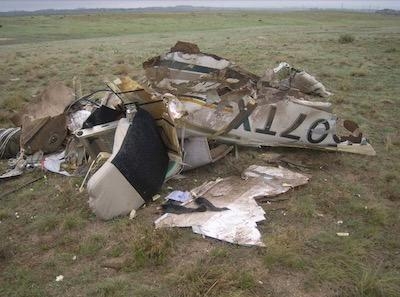Pilot Continued VFR Into IFR Conditions
The NTSB has released a probable cause report from an accident which occurred May 11, 2018 which resulted in the fatal injury of the pilot of a Cirrus SR-22 in Colorado.

According to the report, the instrument-rated private pilot departed on a visual flight rules cross-country flight just before the end of civil twilight. After departing to the north, the pilot turned onto a left downwind to depart the area toward the south; the controller advised the pilot to stay west of the extended runway centerline, which the pilot acknowledged. However, about 2 minutes after takeoff, the airplane turned east and crossed the extended centerline. After crossing the centerline, the controller asked the pilot to state his intentions, and the pilot replied that he was going to return to the airport. The airplane turned back toward the airport and began tracking west toward the extended centerline; radar contact was lost several minutes later.
The airplane impacted a field about 2.5 miles to the south of the approach end of the runway. The airplane was massively fragmented during the impact and debris was scattered for about 1,200 ft. The damage to the airplane and the ground scars at the accident site were consistent with the airplane impacting in a right wing low, nose low attitude with relatively high energy.
The postaccident examination of the engine and propeller assembly did not reveal any preimpact anomalies that would have precluded normal operation. Signatures were consistent with the engine producing power and the propeller developing thrust at the time of impact. While the massive fragmentation precluded functional testing of the flight controls, there was no damage or failure that suggested preimpact anomalies with the airframe or flight controls.
While visual meteorological conditions prevailed at the airport, statements from two pilots flying instrument approaches to runway 35R suggest that the pilot likely encountered and was flying in the clouds to the south of the airport just before the accident.
A review of radar data and voice communications revealed that the instructions issued by the controller, to the pilot, were reasonable and in accordance with air traffic control procedures. Investigators were not able to establish why the pilot did not comply with air traffic control instructions.
The accident flight was the airplane's first flight after completion of an annual inspection, and the pilot was flying to meet his family for an event in another state. It is likely that the pilot was experiencing self-induced pressure to complete the flight as planned in order to maintain the family's schedule of events, and as a result, chose to depart on the visual flight rules flight over mountainous terrain at night in marginal weather conditions. The pilot's logbook was not recovered, and the recency of his instrument flight experience could not be determined.
Based upon the reported weather conditions, the location and fragmentation of the wreckage, and radar data, it is likely that the pilot experienced spatial disorientation shortly after entering the clouds which resulted in a loss of control and descent into terrain. The reason for the pilot's stated intention to return to the airport after takeoff could not be determined, but it is possible that he became distracted and that distraction contributed to his disorientation and loss of control.
The NTSB determined the probable cause of this accident to be the pilot's loss of control due to spatial disorientation. Contributing to the accident was the pilot's self-induced pressure to fly the airplane at night in marginal weather conditions.
(Image from NTSB accident docket)
 Bolen Gives Congress a Rare Thumbs-Up
Bolen Gives Congress a Rare Thumbs-Up The SportPlane Resource Guide RETURNS!!!!
The SportPlane Resource Guide RETURNS!!!! Buying Sprees Continue: Textron eAviation Takes On Amazilia Aerospace
Buying Sprees Continue: Textron eAviation Takes On Amazilia Aerospace Hawker 4000 Bizjets Gain Nav System, Data Link STC
Hawker 4000 Bizjets Gain Nav System, Data Link STC Echodyne Gets BVLOS Waiver for AiRanger Aircraft
Echodyne Gets BVLOS Waiver for AiRanger Aircraft



